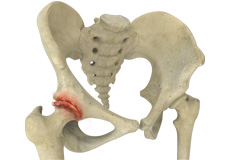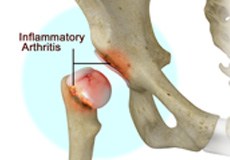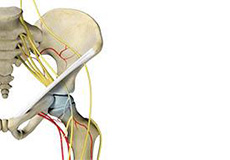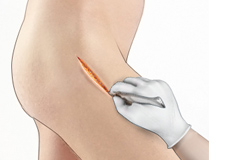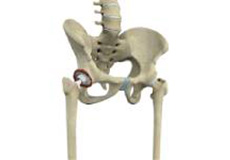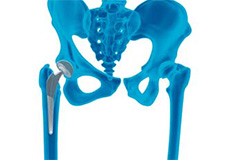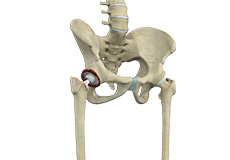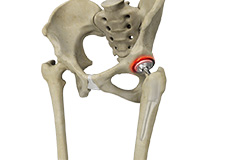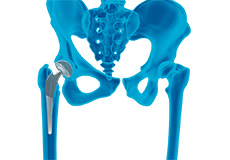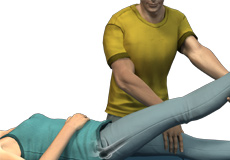Hip Anatomy
The hip joint is the largest weight-bearing joint in the human body. It is also referred to as a ball and socket joint and is surrounded by muscles, ligaments, and tendons. The thigh bone or femur and the pelvis join to form the hip joint.
Osteoarthritis of the Hip
Osteoarthritis, also called degenerative joint disease, is the most common form of arthritis. It occurs most often in the elderly. This disease affects the tissue covering the ends of bones in a joint called cartilage. In osteoarthritis, the cartilage becomes damaged and worn out, causing pain, swelling, stiffness and restricted movement in the affected joint.
Inflammatory Arthritis of the Hip
The inflammation of the joints is referred to as arthritis. Inflammation arises when the smooth lining called cartilage at the ends of bones wears away. In some cases, the inflammation is caused when the lining of the joint becomes inflamed as part of an underlying systemic disease. These conditions are referred to as inflammatory arthritis.
Hip Osteonecrosis
Hip osteonecrosis occurs due to disruption of the blood supply to the highest part of the thigh bone (femoral head). Due to lack of nourishment, the bone tissue of the femoral head dies and gradually collapses, which may further lead to degeneration of the underlying cartilage.
Hip Pain
Hip pain is a common complaint. Hip pain may not always be felt precisely over the hip joint and can occur around the hip joint. The cause for pain could be many different things and the exact position of your hip pain suggests the probable cause or underlying condition causing it.
Hip Fracture
The hip joint is a "ball and socket" joint. The "ball" is the head of the femur or thighbone, and the "socket" is the cup-shaped acetabulum. The joint surface is covered by a smooth articular surface that allows pain-free movement in the joint.
Hip Dislocation
The hip joint is a "ball and socket" joint. The "ball" is the head of the femur or thighbone, and the "socket" is the cup-shaped acetabulum. The joint is surrounded by muscles, ligaments, and tendons that support and hold the bones of the joint in place. Hip dislocation occurs when the head of the femur moves out of the socket.
Minimally Invasive Total Hip Replacement
Minimally invasive total hip replacement is a surgical procedure performed through a small incisions rather than the single long incision of 10 - 12 inches as in the traditional approach.
Revision Hip Replacement
During total hip replacement, the damaged cartilage and bone are removed from the hip joint and replaced with artificial components. At times, hip replacement implants can wear out for various reasons and may need to be replaced with the help of a surgical procedure known as revision hip replacement surgery.
Outpatient Hip Replacement
Hip replacement surgery is one of the most common orthopedic surgeries performed. It involves the replacement of the damaged hip bone (ball shaped upper end of the femur) with a ceramic ball attached to a metal stem that is fixed into the femur and placing a new cup with a special liner in the pelvis.
Correction of a Failed Hip Replacement
Reoperation of a total hip replacement to resolve a painful hip condition arising out of a damaged or worn out prosthesis (artificial hip joint) is known as correction of a failed hip replacement. During this corrective surgery, a partial or complete exchange of the prostheses that were implanted during the original surgery is done.
Correction of a Painful Hip Replacement
Reoperation of a total hip replacement to resolve a painful hip condition arising out of a damaged or worn out prosthesis (artificial hip joint) is known as correction of a painful hip replacement. During this corrective surgery, a partial or complete exchange of the prostheses that were implanted during the original surgery is done.
Correction of a Loose Hip Replacement
Reoperation of a total hip replacement to resolve a painful hip condition and loss of motion due to a loosened prosthesis (artificial hip joint) is known as correction of a loose hip replacement. This loosening occurs due to wear and tear of the implant surfaces and subsequent weakening of the surrounding bone.
Physical Therapy for Hip
Physical therapy is an exercise program that helps you to improve movement, relieve pain, encourage blood flow for faster healing, and restore your physical function and fitness level. The main aim of physical therapy is to make your daily activities, such as walking, getting in and out of bed and climbing stairs, easier.
Activities After Hip Replacement
Hip replacement is a surgery performed to replace parts of a diseased hip joint with a prosthesis. The goal of hip replacement is to eliminate pain and enable you to return to your normal activities.

